Co-Design Canvas
Manas Bhatia

Why?
Spatial Discord within the studio and across the city
This project began with an observation: a table in our GSAPP studio meant for our department, yet often used by others. It wasn't a confrontation, just a quiet tension that blurred ownership and disrupted focus. That moment opened up a broader question: Who decides how space is used and for whom?
I began to notice how easily spatial norms are assumed rather than discussed. To surface this unspoken friction, I started with a survey, asking students how they experience the studio. The answers were varied, unresolved. But they didn't need resolution. They became parameters for a new kind of design process.
This led me to think about similar spatial conflicts in the city. Take the Elizabeth Street Garden in New York. The city plans to build affordable housing there. Residents want to protect the garden. The result is protest and a deep divide.
What these examples show is a larger issue: Spatial Design often follows a top-down process. Even when tools like surveys or forums are used, they rarely allow for creative input or real collaboration. In design thinking, we talk about co-creation. But in spatial design, the tools for co-creation are limited or inaccessible.

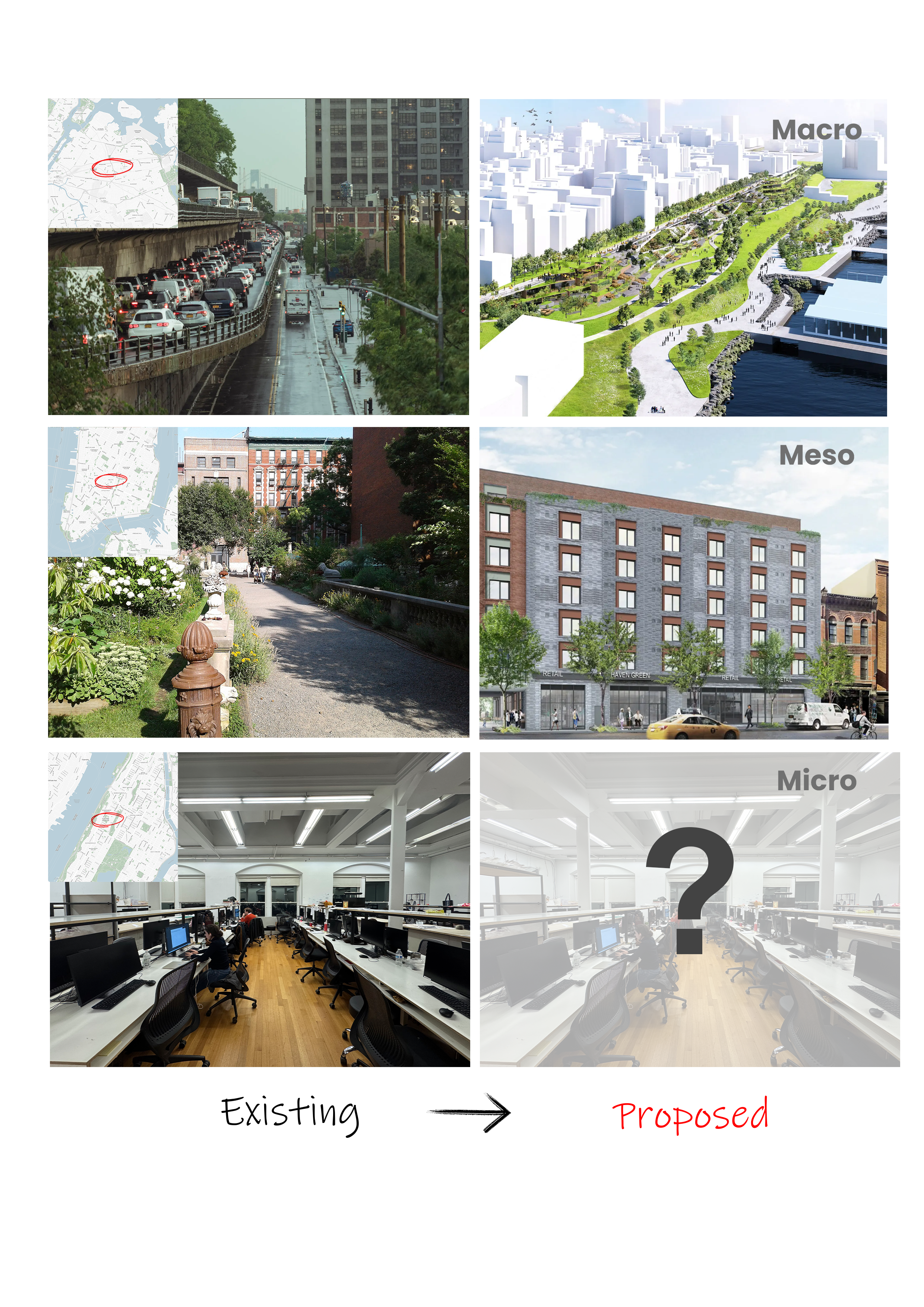
What is Co-Design Canvas?
A sketchbook for collaborative spatial design
So I curated a system where people can engage in spatial decision-making—visually and intuitively. This is Co-Design Canvas. It's like a shared design sketchbook ~ open to anyone.

To ground this tool contextually, I began with a small survey about our GSAPP studio. I collected feedback from students and used LLM to analyse and define five key themes like privacy, lighting, flexibility, collaboration. These themes became what I call space modifiers in the interface. When toggled they add pregenerated text to add on top of the prompts you write. So even the tool is co-designed with its users.
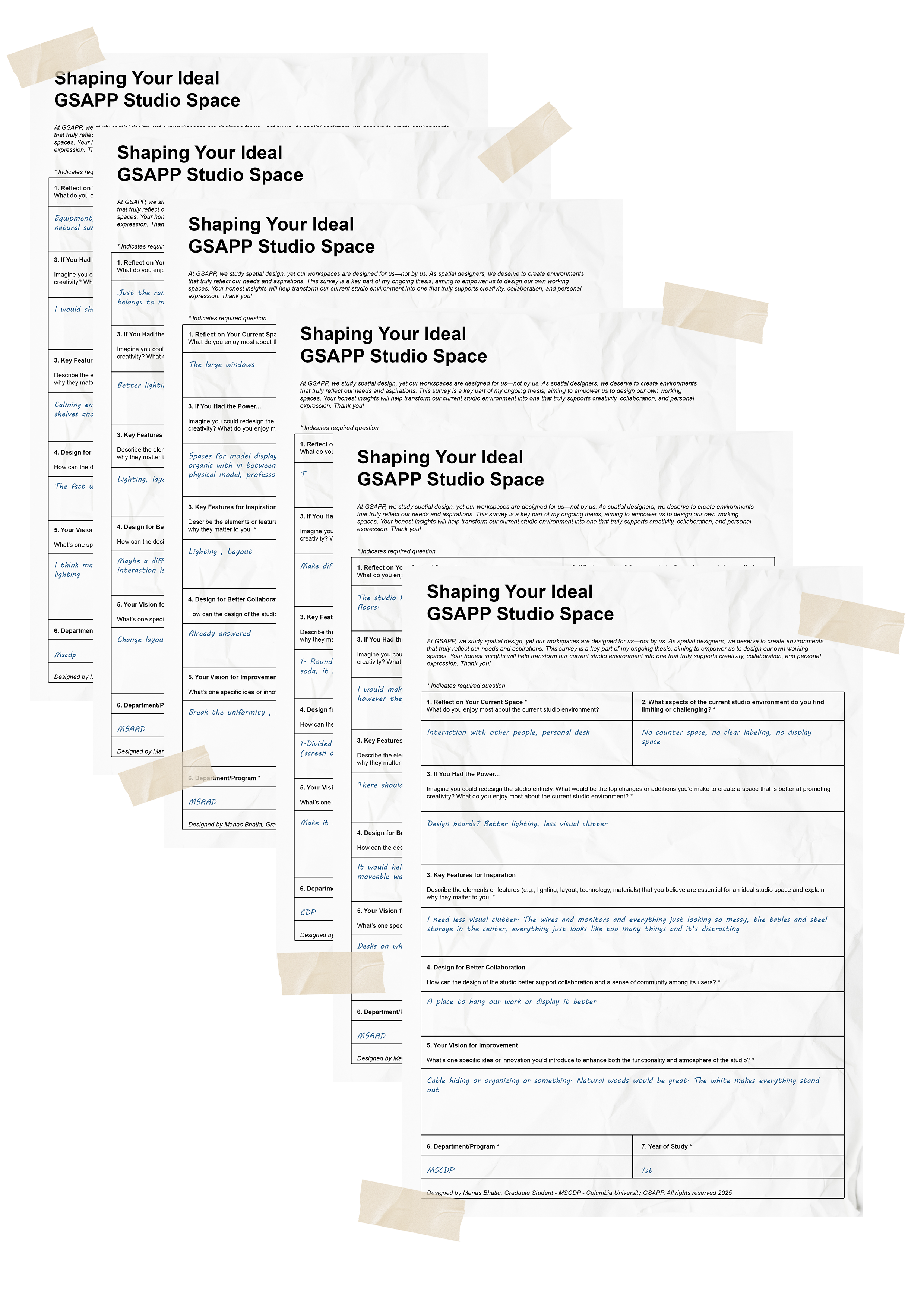
How to create with Co-Design Canvas?
A Step-by-Step Guide to Co-Creating Space
Select, Describe, Change
Users begin by selecting either an interior view of the GSAPP studio or a Google Street View location on campus. They can then mark areas for change using the Magic Wand tool, adjusting its size, erasing, or clearing as needed. After describing their intended modification in the prompt bar, clicking 'Generate' transforms the image using AI, allowing anyone to visualize spatial ideas without technical expertise.
Survey To Sliders
The tool introduces custom sliders: Sunlight, Movement, Privacy, and Harmony, derived from a thematic analysis of survey responses using OpenAI's language model. These sliders allow users to fine-tune spatial qualities of the GSAPP studio view, offering intuitive control over lighting, activity, seclusion, and spatial balance. Combined with the prompt bar, this enables more nuanced, participatory image generation aligned with user intent.
Collective Vision
Finalized visualizations are submitted to a shared interactive map, forming a collective record of spatial aspirations. Users can view and vote on submissions, fostering community feedback. Real-time collaboration allows synchronous editing, while an integrated AI system analyzes submissions at the cluster level extracting key themes and generating downloadable reports that surface patterns, preferences, and collective priorities.
Edit Together, In Real Time
One of the core features of Co-Design Canvas is its real-time collaborative editing environment. Multiple users can simultaneously interact with the same image, propose modifications, and build upon each other's visualizations. This synchronous participation not only fosters dialogue but also transforms spatial design into a shared, iterative process where negotiation, disagreement, and collective imagination coexist on a single canvas.
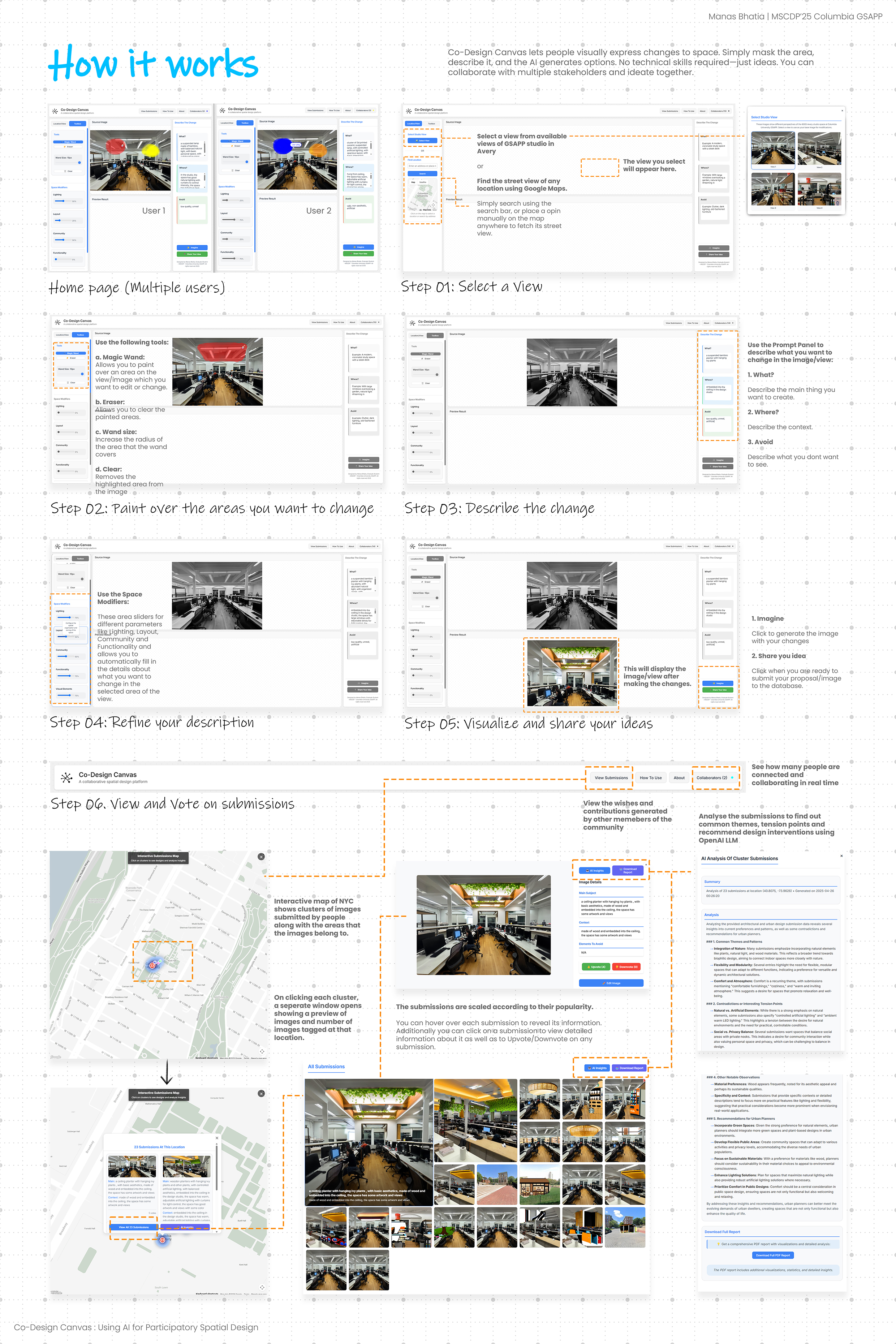
What Powers This?
The Algorithms, Interfaces, and AI Behind the Canvas
The Co-Design Canvas platform is built on a modular computational system that integrates AI-based visualization, real-time collaboration, and spatial anchoring. Initially developed and tested locally using open-source AI models downloaded from platforms such as Hugging Face and Civitai, the system leveraged custom workflows in ComfyUI for segmentation masking, prompt embedding, and latent diffusion image generation[5].
During this phase, the models were carefully selected to suit architectural and urban design contexts. Upon deployment, the pipeline was adapted for remote hosting: the AI workflow runs on RunPod.io, using available GPU resources and pre-installed models, which may differ from those used locally depending on RunPod's infrastructure. The backend, built with Flask, is hosted on Render.com, managing all API communications and user interactions. Firebase stores user inputs and generated outputs in real time, while WebSockets enable synchronous editing across multiple users.
A custom front end, deployed via GitHub Pages and connected to a GitHub-hosted repository, provides an intuitive interface with AI-derived sliders and prompt inputs. Submissions are geo-located through the Google Maps API, grounding each visualization in a specific context. Rather than producing fixed outcomes, the platform supports continuous layering of perspectives—transforming conflict into a medium for collective authorship.
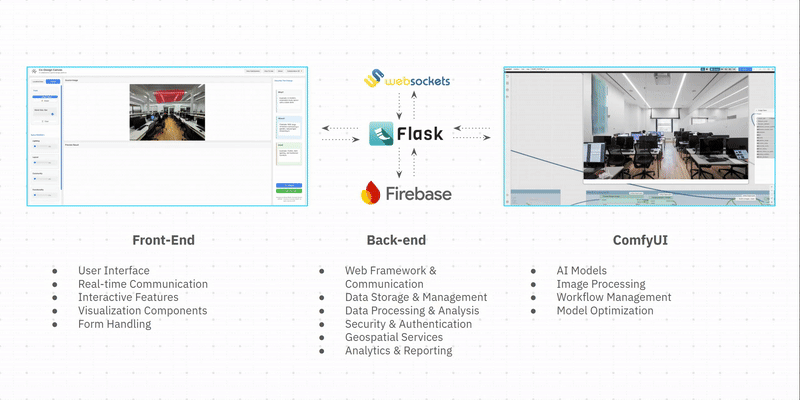
GSAPP collective vision
From prompts to visuals
These images represent the collective visions of GSAPP students, generated through our Co-Design platform. Each visual reflects a unique interpretation of how the GSAPP studio and plaza could evolve — capturing aspirations for collaboration, creativity, and community. By translating individual inputs into visual outputs, the platform revealed both common desires and diverse imaginations, highlighting the power of participatory design in shaping shared spaces.
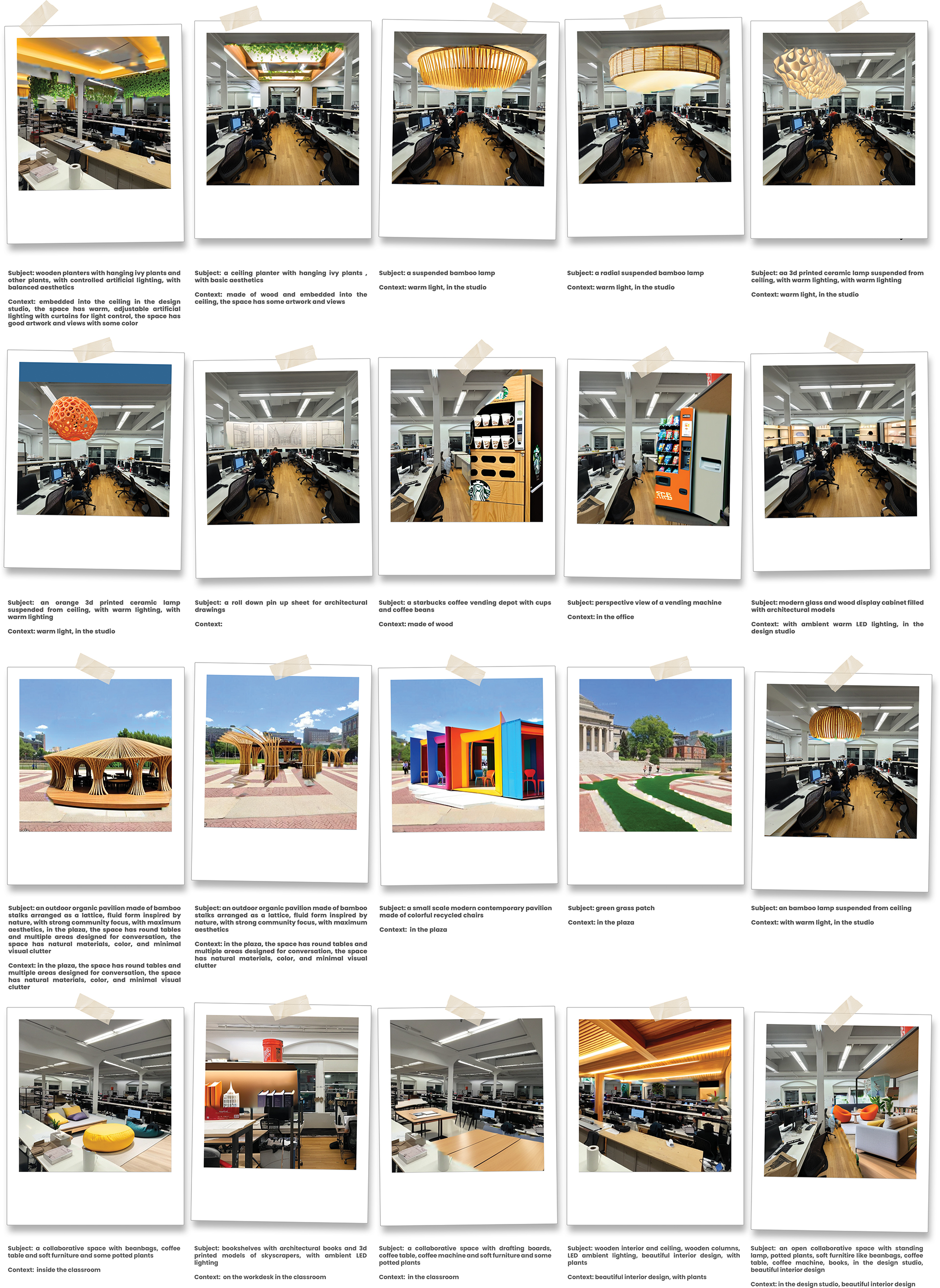
Scaling the Canvas
Micro to Macro
Co-Design Canvas is designed to scale beyond the confines of the studio, extending to contexts such as community parks, shared streets, and large-scale urban developments like the East River Park project. As the platform gathers more community-generated data, this input can be used to fine-tune the underlying AI models, making them increasingly contextual, semantically nuanced, and responsive to the specific needs and aspirations of diverse urban environments.
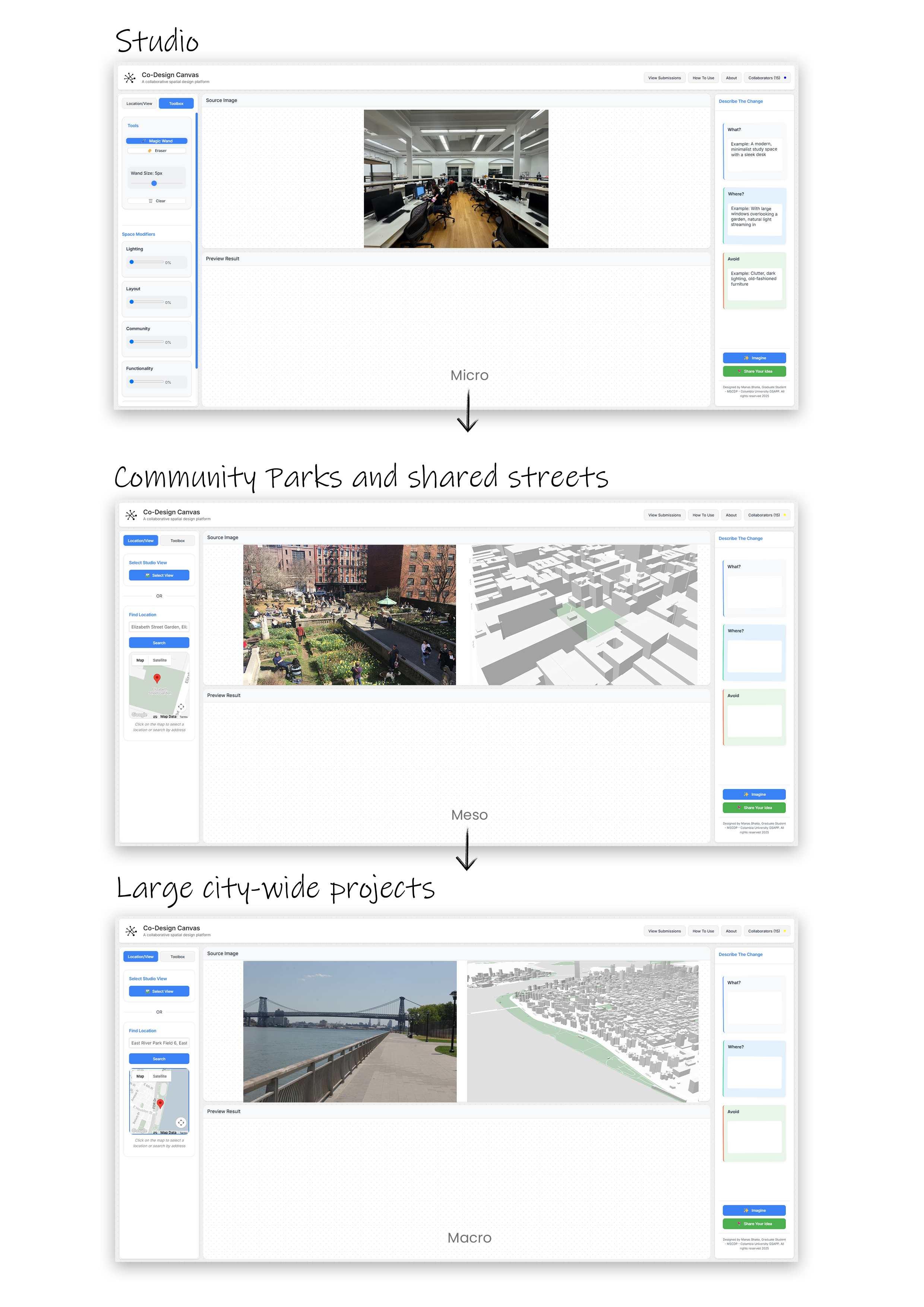
Mediator not Master
AI's role in Co-Design Canvas
AI in Co-Design Canvas operates not as a singular tool but as a dynamic set of roles that collectively mediate between community input and spatial output. Its roles include:
- Translator: Converts text prompts, survey responses, and conversations into visual representations.
- Bridge: Lowers technical barriers for non-experts to engage in design.
- Co-Creator: Contributes to both the generation of ideas and the tools that enable them.
- Intern: Supports prototyping and coding tasks.
- Analyst: Extracts themes from community data to inform interface design.
- Comparator: Identifies patterns across generated outputs.
- Collaborator: Enables open-ended exploration.
- Mediator: Surfaces divergent views without forcing resolution.
- Human Ally: Supports collective authorship and returns agency to people in contexts of spatial conflict or disagreement.
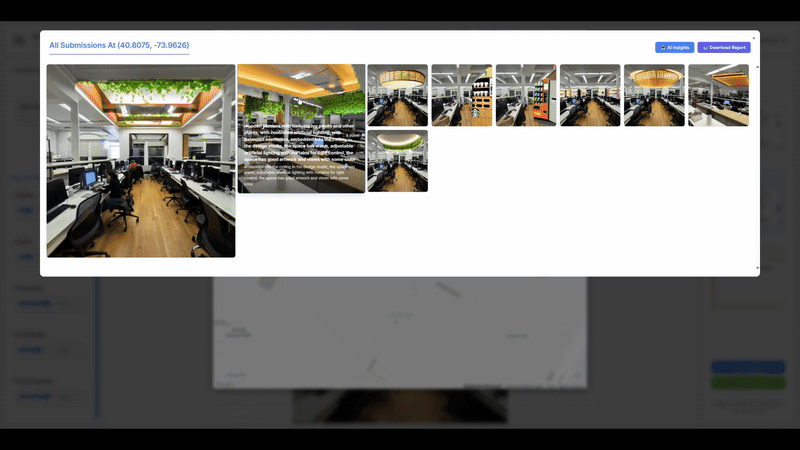
The tool reveals patterns, but does not aim to resolve them. It allows a space to record spatial imagination. The platform doesn't erase disagreement. It holds it long enough to understand what's at stake. In doing so, it allows us to stay with the complexity of collective design—not to simplify it, but to stay present within it.
In the spirit of Georgeen Theodore's[6] call to rethink advocacy as an interdisciplinary and speculative practice, this work takes on one such mode of operation—designing not just spatial outcomes, but frameworks through which communities can co-author their environments.
Who's Behind Co-Design-Canvas?
An artist at heart, architect by profession, exploring design technology.
A transformative journey
I'm Manas Bhatia, a licensed architect from India whose interdisciplinary practice spans architecture, visual storytelling, speculative design, and an enduring love for masala chai. Co-Design Canvas is a capstone project developed as part of the Master of Science in Computational Design Practices (M.S.CDP) at Columbia University's Graduate School of Architecture, Planning, and Preservation (GSAPP). The CDP program is anchored by a three-semester core sequence—Colloquium I, II, and III—that scaffolds the research and development of an independent thesis project.
Over the course of three semesters, I shaped this project from concept to execution. In the first semester, I started exploring the idea of how generative AI being an "organic" technology could change the way designers work, while the second and third semesters were dedicated to developing that thought through rigourous reseach and improvisation, as well as implementation and refinement.
I am thankful to the entire MSCDP'25 cohort for inspiring and motivating me throughout the course tenure. Special thanks to Snoweria Zhang and Laura Kurgan for guiding my research and aspirations into a comprehensive research,and showing me what critical design thinking truly means in Colloquium II, and Seth Thompson and Catherine Griffiths, for their thoughtful discussions, ideas and support in Colloquium III.
This project would not have reached its full potential without the mentorship of my advisor, David Benjamin, whose guidance not only strengthened my design confidence but also challenged me to conceive of the work not merely as a tool, but as a critical narrative embedded within broader frameworks of design thinking and speculation.
Special thanks to my peers — Genda, Sebastian, Hao, John, Vaibhav, Julia, Yilin, and Sissie for their unwavering support, insightful conversations, and the many generative discussions that shaped the evolution of this project.
I would also like to extend my gratitude to the faculty and courses I engaged with throughout the program (listed below), each of which significantly broadened my perspective on data, computation, design, and their entanglement with political and ethical questions.
• Computational Design Workflows by Celeste Layne.
• Computational Modeling by Meli Harvey and Luc Wilson.
• Mapping Systems by Mario Giampieri.
• Methods As Practices by William Martin and Violet Whiteney.
• GIS for Design Practices by Dare Brawley and Mario Giampieri.
• Environmental Data Analysis by Peter Marcotullio and Kaz Sakamoto.
• Re-thinking BIM by Joseph Brennan.
• Design Intelligence by Danil Nagy.
• Colloquium II - Explore,Explain,Propose by Laura Kurgan and Snoweria Zhang.
• Spatial AI by William Martin
• Making Senses by James Nanasca
• Virtual Architecture by Nitzan Bartov
• Colloquium III - Design in Action by Seth Thompson and Catherine Griffiths
References
Hsu, Y.-C., Huang, T.-H. K., Verma, H., Mauri, A., Nourbakhsh, I., & Bozzon, A. (2022). Empowering local communities using artificial intelligence. Patterns, 3(3), 100449. https://doi.org/10.1016/j.patter.2022.100449
Williams, Sarah, Sara Beery, Christopher Conley, Michael Lawrence Evans, Santiago Garces, Eric Gordon, Nigel Jacob, and Eden Medina. 2024. "People-Powered Gen AI: Collaborating with Generative AI for Civic Engagement." An MIT Exploration of Generative AI, September. https://doi.org/10.21428/e4baedd9.f78710e6.
Bibri, S. E., Huang, J., Jagatheesaperumal, S. K., & Krogstie, J. (2024). The synergistic interplay of artificial intelligence and digital twin in environmentally planning sustainable smart cities: A comprehensive systematic review. Environmental Science and Ecotechnology, 20, 100433. https://doi.org/10.21428/e4baedd9.f78710e6.
Bloomberg News. (2024, March 13). AI-powered urban innovations bring promise, risk to future cities. Bloomberg. Retrieved from https://www.bloomberg.com/news/articles/2024-03-13/ai-powered-urban-innovations-bring-promise-risk-to-future-cities
PixelEasel. (2024). ComfyUI Inpaint Anything workflow. YouTube. Retrieved from https://youtu.be/_LuPU5woth0?si=bNdQCTphMrKyBn2O
Theodore, G. (2009). Advocacy? Three Modes of Operation for the Activist Architect," field 3, no. 1 (2009): 59–74, https://www.field-journal.org/article/id/32/.
Stieb, Matt. "Big Trouble in Little Paradise: The decadelong battle over the Elizabeth Street Garden nears its end." New York Magazine, July 18, 2023. https://nymag.com/intelligencer/2023/07/elizabeth-street-garden-affordable-housing-battle.html
Barron, James. "Elizabeth Street Garden, Defended by De Niro, Scorsese and Patti Smith, Is Set to Be Razed." The New York Times, August 22, 2024. https://www.nytimes.com/2024/08/22/nyregion/elizabeth-street-garden-deniro-scorsese-smith.html?smid=url-share
Arensberg, Danny, and Rory Lustberg. "Elizabeth Street Garden: A Decade-Long Battle Over Green Space and Housing." Washington Square News, October 9, 2024. https://nyunews.com/news/2024/10/09/elizabeth-street-garden/
Schulman, Pansy. "Elizabeth Street Garden Gets Temporary Stay of Eviction." Architectural Record, 2024. https://www.architecturalrecord.com/articles/17174-elizabeth-street-garden-gets-temporary-stay-of-eviction
Rosenthal, Nicole. "NYC's Elizabeth Street Garden fights to stay open days before eviction — but city isn't budging: 'We're not packing up.'" New York Post, October 14, 2024. https://nypost.com/2024/10/14/us-news/nycs-elizabeth-street-garden-fights-to-stay-open-days-before-eviction-but-city-isnt-budging-were-not-packing-up/
Thoughts
As a first-time coder, this project would not have been possible without the support of accessible AI tools. Leveraging open-source models and workflows, LLMs like ChatGPT by OpenAI, and the Claude Sonnet-powered Cursor notebook, I was able to focus on designing the system—its logic, experience, and values—rather than getting constrained by the technical complexity of building everything from scratch. What might have taken a team months to develop became achievable within a semester, not because the process was automated, but because AI enabled deeper thinking at the level of systems and participation. In this sense, AI did not diminish the role of the designer—it amplified it. It allowed me to operate more critically and expansively, reaffirming that in the age of AI, the designer's role as curator, mediator, and systems thinker is more vital than ever.
Stieb, Matt. "Big Trouble in Little Paradise: The decadelong battle over the Elizabeth Street Garden nears its end." New York Magazine, July 18, 2023. https://nymag.com/intelligencer/2023/07/elizabeth-street-garden-affordable-housing-battle.html ↩︎
Barron, James. "Elizabeth Street Garden, Defended by De Niro, Scorsese and Patti Smith, Is Set to Be Razed." The New York Times, August 22, 2024. https://www.nytimes.com/2024/08/22/nyregion/elizabeth-street-garden-deniro-scorsese-smith.html?smid=url-share ↩︎
Arensberg, Danny, and Rory Lustberg. "Elizabeth Street Garden: A Decade-Long Battle Over Green Space and Housing." Washington Square News, October 9, 2024. https://nyunews.com/news/2024/10/09/elizabeth-street-garden/ ↩︎
Schulman, Pansy. "Elizabeth Street Garden Gets Temporary Stay of Eviction." Architectural Record, 2024. https://www.architecturalrecord.com/articles/17174-elizabeth-street-garden-gets-temporary-stay-of-eviction ↩︎
PixelEasel, "ComfyUI Inpaint Anything workflow," YouTube video, 2024, https://youtu.be/_LuPU5woth0?si=bNdQCTphMrKyBn2O. ↩︎
Georgeen Theodore, "Advocacy? Three Modes of Operation for the Activist Architect," field 3, no. 1 (2009): 59–74, https://www.field-journal.org/article/id/32/. ↩︎